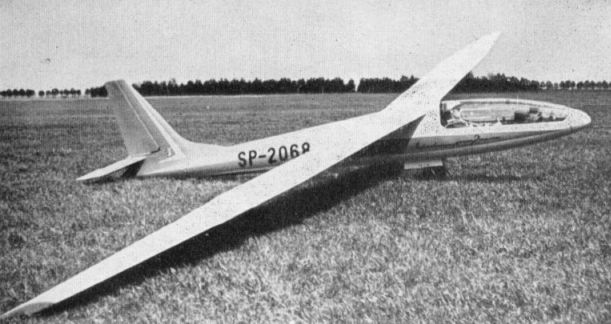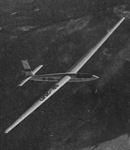
Варианты
- PZL - SZD-19 Zefir / SZD-24 Foka / SZD-31 Zefir 4 - 1959 - Польша
- PZL - SZD-36 Cobra - 1969 - Польша
M.Hardy. Gliders & Sailplanes of the world
SZD-24 Foka
Appropriately named Foka (or Seal) on account of its beautifully streamlined fuselage, this high performance Standard Class single-seater was designed by Dipl-Ing Wladislaw Okarmus and first flew in prototype form on 2 May 1960. Flown by Adam Witek, the Foka gained 3rd place in the Standard class in that year's World Championships in Germany, where the type's design features aroused considerable interest. Three pre-production aircraft designated SZD-24B Foka 2 were completed early in 1961, and the first major production variant was the SZD-24C Foka-Standard, which first flew in September 1961; deliveries to the Polish gliding clubs and to export customers began soon after. This version was succeeded in production by the SZD-24-4A (or SZD-24D) Foka 4, which first flew in prototype form in February 1962 and later took part in the 1963 World Championships in Argentina. The Mk 4 had the same fuselage as the Foka-Standard but the wing structure was redesigned to make it much simpler and less costly to produce while retaining the same aerodynamic shape. The first production Foka 4A made its first flight on 7 February 1964 and four Mk 4As were flown by the Polish team in the 1965 World Championships at South Cerney, Gloucestershire; in one of these Jan Wroblewski won the Open Class and his team-mate E. Makula came 4th, while the Fokas flown by F. Kepka and J. Popiel took 3rd and 4th places in the Standard Class. Of all-wood construction, the Foka 4A has two-piece cantilever shoulder wings which are sparless torsion box structures with thick plywood sandwich stressed skin covering which replaces the Foka-Standard's plywood and foam skinning; the letter's wing had a central torsion box structure built up of a main spar and two auxiliary spars. There are special SZD plain ailerons of NACA 4415 section. No flaps are fitted but there are SZD metal air brakes at the 60% chord line. The wooden monocoque fuselage is unusual in that the forward part has a modified laminar section, with the maximum depth aft of the pilot's cockpit at 40% wing root chord; the forward section is covered with a plywood/glassfibre sandwich skin. The pilot sits in a fully-reclining seat under a large flush-fitting canopy which slides forward to open; blind flying instrumentation is standard and there is provision for radio and oxygen. The landing gear consists of a long skid under the nose and a non-retractable monowheel located well aft of the cg, plus a tail bumper. The swept fin is integral with the fuselage and, like the tailplane, is an all-wooden sandwich structure; the laminar flow tailplane and elevator slot into the rear fuselage cone below and behind the rudder in a manner very similar to the Zefir 2. The elevator and rudder are fabric-covered and there is a trim tab in the former.
Final production version was the SZD-32A Foka 5 (formerly SZD-24E), which first flew in prototype form on 28 November 1966 and received its Polish C of A on 7 October 1967; this differed from the Mk 4 chiefly in having a roomier cockpit and the one-piece wooden tailplane and elevator repositioned at the top of the fin. The Foka 5 won first prize at the 1968 OSTIV Congress for the best Standard Class sailplane and a Mk 5 flown by Eward Makula finished 8th in the Standard Class in that year's World Championships at Leszno, Poland. Altogether 330 Fokas of all variants had been built when production of the type ended in 1971, and 200 of these were exported to 17 countries. The Foka 5 had several other changes from the Mk 4: the wing section was slightly different and the plywood-covered wing was now a multi-longeron semi-monocoque structure, with spars in the inboard section of each panel only; ailerons and air brakes were the same. The fuselage is now a semi-monocoque of oval section, with the monowheel relocated to be under the cg when the aircraft is empty; its brake is linked with the air brakes and the nose skid is retained. The cockpit canopy is slightly shorter but the pilot has the same blind flying instrumentation and provision for radio and oxygen as on the Mk 4.
Data: Foka 5
Span: 49 ft 2 in
Length: 23 ft 6 1/2 in
Height: 5 ft 3 1/2 in
Wing area: 130.9 sq ft
Aspect ratio: 18.5
Empty weight: 565 lb
Max weight: 850lb
Max speed: 155 mph (in smooth air)
Min sinking speed: 2.03 ft/sec at 48 mph
Best glide ratio: 36.3:1 at 53 mph
SZD-31 Zefir 4 Poland
The Zefir series of high performance single-seaters represented what was arguably the high point of wood and fabric sailplane design before this traditional form of construction was superseded increasingly by glassfibre types in the 1960s. The Zefirs resulted from work done by a team under Dipl-Ing B.Szuba and the SZD-19X Zefir 1 prototype, designed by B. Szuba, made its first flight on 4 January 1959 as an Open Class single-seater and this was followed by the SZD-19-2 Zefir 2, which first flew in March 1960. The first two examples of this version, flown by the Polish pilots Makula and Popiel, took 2nd and 3rd places in the Open Class in that year's World Championships in Germany. The Zefir aroused great interest here because of its advanced design features, in particular the reclining pilot's position that made possible such a well-streamlined fuselage of low cross sectional area, the tail braking parachute, the towing hook unit combined in the retractable monowheel, and the swept back fin and rudder with the one-piece tailplane and elevator slotting into the tail cone below the rudder. The Zefir 2 went into limited production during 1963-64 and three improved Zefir 2As took part in the 1963 World Championships in Argentina; this time their pilots Makula and Popiel came 1st and 2nd in the Open Class and the Argentine pilot Rudolfo Hossinger, who had won the 1960 World contest in a Skylark 3, was placed 5th in a Zefir 2A. The cantilever shoulder wings were of 17m (55ft 9 1/2 in) span and 20.7 aspect ratio, with an NACA 65-series laminar flow section; each wing has a central plywood torsion box with a plywood/plastic core sandwich skin, a D-section leading edge and a plywood-covered trailing edge. The wooden ailerons are fabric-covered and the VZLU mechanically-operated slotted flaps are in six sections covering 35% of the chord; there are no dive brakes. The wooden fuselage has the monocoque nose section covered with glassfibre, the centre section and tail cone being ply-covered semi-monocoque structures, the drag parachute being housed in the tail cone. The tail surfaces have laminar flow sections, the fin and tailplane being covered with a sandwich skin and the rudder and elevators fabric-covered, with a trim tab in the elevator. The long flush-fitting cockpit canopy slides forwards about 3in and then is opened by hinging upwards from the tip of the nose cone; radio, oxygen and blind flying instruments for the pilot are standard, and a thermal detector can be fitted as an optional 'extra'.
The SZD-29 Zefir 3 was a much improved version of the Mk 2 intended for advanced competition flying, with a wing of 19m (62ft 4in) span, full-span Fowler flaps, a longer fuselage and an unswept fin and rudder; the Mk 3 first flew in prototype form in April 1965 and had an improved best glide ratio of about 42:1. Its production development was the Zefir 4, the first Mk 4 prototype making its maiden flight on 7 December 1967. It was developed for the 1968 World Championships, in which one flown by Jan Wroblewski came 14th in the Open Class. The wing has an NACA 66-series section and no dihedral, unlike the Mk 2's; it is a multi-longeron sparless stressed skin wooden structure with full-span flaps like the Mk3's, the outer sections of which are wooden and also act as ailerons while the inboard sections are of plywood/balsa sandwich; unlike the Mk 2, double metal air brakes are featured. The fuselage is an oval section monocoque, the forward part being made of glassfibre laminate and the rear portion of wood. The tailplane is an all-moving mass-balanced surface with trim tab, and the unswept rudder is also mass-balanced. The monowheel is manually retractable with rubber shock absorbers and a hand-operated wheel brake and, like the Mk 2, a tail-braking parachute is fitted; unlike the Mk 2, the cockpit canopy is now sideways-hinging.
Data: Zefir 4
Span: 62 ft 4 in
Length: 26 ft 3 in
Height: 7 ft 0 in
Wing area: 169 sqft
Aspect ratio: 23.0
Empty weight: 772 lb
Max weight: 970 lb
Max speed: 149 mph (in smooth air)
Max aero-tow speed: 93 mph
Min sinking speed: 1.97 ft/sec at 58 mph
Best glide ratio: 42:1 at 58.5 mph
- M.Hardy. Gliders & Sailplanes of the world
Фотографии
-
Jane's All the World Aircraft 1966 / 05 - Sailplanes
Регистрационный номер: SP-2068 SZD-19/2 Zefir 2 single-seat high-performance sailplane
-
Air-Britain Archive 1984-03
Регистрационный номер: OO-ZGY SZD-19 Zefir 2A sailplane OO-ZGY (2286) wearing its owner's initials 'JE' on the tail.
-
Jane's All the World Aircraft 1964 / 03 - Sailplanes
Регистрационный номер: SP-2392 Production version of the SZD-24C Foka Standard sailplane
-
Jane's All the World Aircraft 1966 / 05 - Sailplanes
Регистрационный номер: SP-2451 SZD-24D Foka 4A single-seat Standard Class sailplane
-
Jane's All the World Aircraft 1972 / 03 - Sailplanes
Регистрационный номер: SP-2517 SZD-31 Zefir 4 single-seat high-performance sailplane
-
Jane's All the World Aircraft 1972 / 03 - Sailplanes
Регистрационный номер: SP-2504 SZD-32A Foka 5, the latest T-tail version of this Standard Class sailplane
- Фотографии





